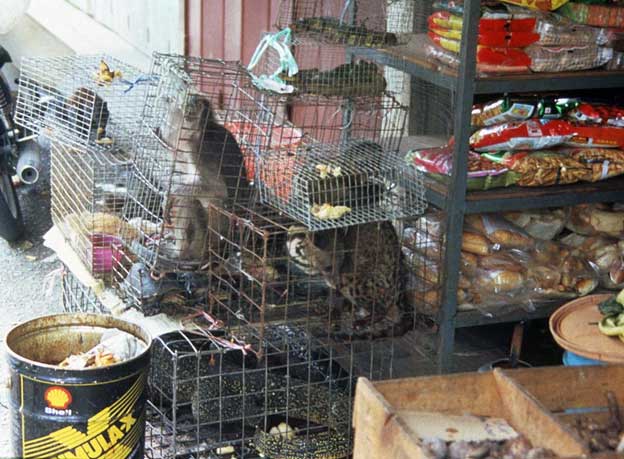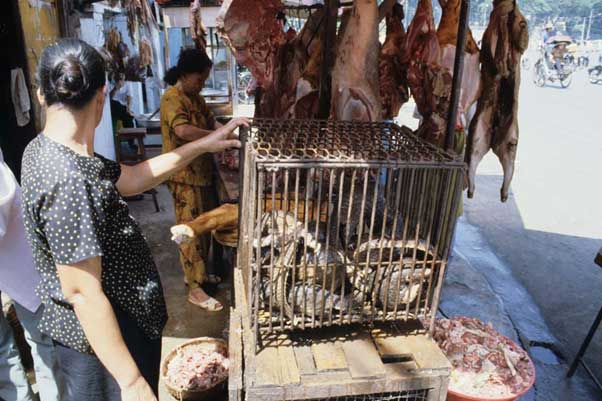COVID-19 & Human Health Risks Linked to Wildlife Trade Practices

CAMBRIDGE, UK, May 07 (IPS) - At the time of writing, the COVID-19 pandemic is raging worldwide, causing human mortality and socio-economic disruption on a massive scale and it appears highly likely that profound impacts will continue for many years to come.
Although the precise origins of the disease remain unproven, there are strong indications of a wild animal source and a direct link to wildlife trade in China.
Even if evidence points elsewhere in future, the magnitude of the current outbreak places under an intense spotlight concerns raised by zoonotic disease experts over many decades about human health risks linked to wild animal trade in the increasingly inter-connected global economy.
As calls for new health-focused restrictions on wildlife trade have increased in volume in response to the current pandemic, some countries have taken immediate action. Building on immediate emergency restrictions placed on wildlife markets in January 2020, China is implementing a long-term prohibition on trade and consumption of wild animals for food as a public health protection measure.
Viet Nam is also considering new health-focused market restrictions and Gabon has introduced new species-specific trade restrictions. Looking ahead, there is a critical need to improve understanding of what sort of interventions might make the biggest difference in reducing risks of zoonotic disease emergence.
However, it is also important to work out how such actions might best complement, rather than conflict with, the range of existing conservation-focused wildlife trade regulation and management measures that are already struggling to contain over-exploitation of nature by people.
Zoonotic disease risks have not been wholly ignored before now. Many countries have live animal quarantine requirements and other rules governing the cross-border movement of meat, fish and other animal products.
Similarly, production, trade and use of live animals and products are subject to animal and human health regulations within domestic markets of most countries. However, such measures are typically designed primarily to address trade and consumption of domesticated species, the volume and value of which vastly exceed wild animal business.
As a result, the provisions of such regulations are seldom tailored to the specific dynamics and risks of the trade in wild animals.
Design of new interventions should be based on evidence-based assessment of disease-related vulnerabilities in current wild animal trade chains. Based on study of past cases, experts point to heightened risks of zoonotic disease spillover in places where large numbers of stressed live animals of different species (wild or domesticated) and people are in close proximity, such as transport hubs, holding facilities and markets.
However, there remains considerable uncertainty about differentiation of risk levels between different wild animal species (or species groups) and about the likelihood of transmission from different wild animal parts and products.

There is a wide range of options for future intervention based on assessment of such risks. Prohibitions on trade and consumption of certain species or products could be warranted. This would likely require new or modified national legislation in many countries, as most current restrictions are explicitly justified by conservation threat levels and jurisdiction is often limited to import/export controls only.
Such measures would of course face the same challenges that undermine existing wildlife trade laws: enforcement is inconsistent, often under-resourced, undermined by criminality and corruption, and given insufficient priority by governments. Risky trade may simply continue through illicit markets.
It is possible that the greatest benefit might come from changes in management practices for holding, trade and processing wild animals in trade. These might include regulatory or voluntary private sector measures aimed to improve animal husbandry, increase separation between species in trade, enhance sanitation at holding facilities and improve personal protection for workers.
These measures may again require modification of existing animal and human health legislation, but there is considerable practical experience from the domesticated animal sector that could be applied to this challenge.
Despite the clear imperative for action provided by the tragic impacts of the COVID-19 pandemic, it will be critical to ensure that remedial restrictions on wildlife commerce are tailored to achieve specific risk reduction goals and designed to take into account potential negative impacts on social equity, livelihoods, and indirect conservation impacts.
Such measures also need to be set in the context of other zoonotic disease pathways and risk factors that need careful attention, such as land-use change, domestic livestock management practices and other human/wildlife interactions.
It is also vital that amidst the urgent need to reduce zoonotic disease threats from wildlife trade, the ongoing drive to address over-exploitation threats to wildlife does not lose momentum. It is of course possible that new health-focused restrictions on wild animal trade and increased scrutiny of wildlife commerce more generally owing to its likely connection with the pandemic may reinforce conservation-focused action.
However, trade in what may be identified as higher risk sectors, such as that of live wild mammals and birds, makes up a small proportion of the global wildlife trade. The greatest over-exploitation threats are faced by marine species and the biggest wildlife trade flows are of timber and other wild plant products.
There is additional cause for concern that socio-economic impacts of the COVID-19 pandemic may be driving new trends in wildlife trade patterns that need careful attention. Past disease outbreaks linked to wild meat trade have led to increased demands for marine fish and there is already evidence of greater attention to wild plant-based medicinal treatments and tonics.
Although some illegal wildlife trade flows may now be suppressed by transport interruptions and retail market closures, there is every likelihood that criminal syndicates will move fast to rebuild illicit businesses and exploit diversion of government enforcement resources to other priorities.
A new focus on human health risks linked to wildlife trade practices is certainly warranted as a component of wider thought and action on the relationship between people and nature as the COVID-19 epidemic persists.
The response should be targeted, appropriate to the task and its design grounded in experience gained from past wildlife trade interventions. In the same way that human and environmental health are intimately connected, it is essential that new health-focused wildlife trade interventions are considered in concert with those already focused on conservation gain.
The "super-year for biodiversity" may have been delayed, but the imperative for conservation action remains.
An abridged version of the article appeared in the April issue of the TRAFFIC Bulletin, available for download at: https://www.traffic.org/site/assets/files/12779/bulletin-32_1-final-web.pdf
© Inter Press Service (2020) — All Rights Reserved. Original source: Inter Press Service
 Global Issues
Global Issues